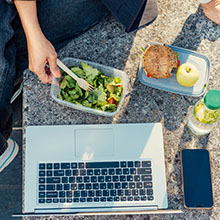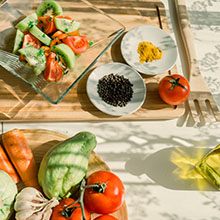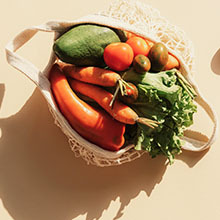Food, gloriously expensive food. And the costs just seem to keep rising thanks to inflation. But that doesn’t mean you need to sacrifice healthy choices.
“Some Canadians may feel they have no choice but to buy processed foods because they believe they can’t afford good nutrition,” says Gina Sunderland, a registered dietitian. “But there are many ways you can stretch your food dollar without sacrificing your health.”
Eating nutritious food can give you physical and financial benefits. For example, life insurance premiums are typically lower for healthy people with healthy lifestyles.
How to be healthy: 10 tips for eating well
Here are 10 dietitian-endorsed ways to help keep your body and bank account healthy:
1. Practice meal planning
When it comes to saving money at the grocery store, planning is the best way to start. Pick a day, maybe a Sunday, and get your plan started:
- Write down the meals you will have for the next 5-7 days. Do this step with your family if you can. The more input you have, the more likely everyone is to eat it. And they may even participate in the cooking and cleaning up!
- Check your fridge and cabinets to see what you have at home. You may have foods already that can be used. Or you may want to plan your meals around foods you need to use before they expire.
- Make a grocery list of what you’ll need to make the meals. If it’s an option, use a ‘click and collect’ or grocery delivery/pick-up option. This is an easy way to help avoid impulse buying.
- Go shopping. But only buy what you know you’re going to use. This way, you won’t end up throwing away what you don’t use.
- Stick to the plan as best you can. It can be tempting to order in instead of cooking on busy days. But remember, you already planned for and bought the food. So, ordering out means you’ll be spending money on food twice.
2. Turn leftover food into new meals
Make twice as much dinner as your family needs. Why? So you can have the leftovers for lunch the next day.
- Making quinoa or rice as a side dish? Double it and use the leftovers as the base of a lunch salad.
- Roasting a chicken? Use your oven more efficiently and roast two chickens. You’ll not only have leftovers for the next day, but also for the freezer.
This way, you'll be able to avoid the expensive, often unhealthy, fast-food choices at lunchtime. Or, if you work from home, you’ll have quick options for lunch on hand. And by cooking once and eating twice, you’ll have less clean up during your busy workday.
3. Eat seasonally
Seasonal eating means eating fruits and vegetables when they’re in season, locally. Eating this way is cheaper for a few reasons:
- It costs less to grow seasonal food, which means it’s cheaper to buy. The time, infrastructure, and resources needed to grow tomatoes in greenhouses in winter, for example, adds up. This cost gets passed onto us as consumers.
- Supply and demand. Farmers can grow more outdoors. And larger quantities mean the items generally cost less.
- Seasonal fruits and vegetables don’t need to travel. Importing food, whether from across the country or across the world, is expensive. When we buy local food that’s in season, import (and usually travel) costs don’t exist.
The key to eating locally is knowing what seasonal foods to buy in Canada. But growing seasons vary from place to place. The best way to know what’s in season is by reading signs and labels. Most retailers and farmers are very eager to advertise when something is local and in season.
While you’re buying, stock up on some seasonal items that freeze or preserve well. Preserving and freezing in-season produce lets you eat “seasonally” and affordably all year long. “I freeze grated and coined carrots to add to soups, stews and spaghetti sauces,” says Sunderland. When tomatoes are ripe, make sauce or puree. Or you can oven-dry them and bag up your creations to freeze for use in many dishes. “I process enough to last through winter,” Sunderland says. “It’s a great way to bring the fresh taste of summer produce to your family’s meals all year round.”
4. Freeze half your bread
Who doesn’t end up throwing out slices in a loaf of bread because it’s gone stale or mouldy? Here’s a fix: When you buy bread, immediately put half into the freezer. Use the fresh slices for sandwiches and use the frozen slices for toast.
“I buy day-old breads and bagels at a reduced price. They’re perfect for toast and French toast,” says registered dietitian Sue Mah, president of Nutrition Solutions.
5. Check for grocery store deals
Don't be quick to throw away grocery store flyers into the recycle bin. You can use them to find deals. You can also find most of these flyers online at a store’s website. Look at various flyers to comparison shop and see which one offers the best deals. If you’re buying online for grocery pick up or delivery, start in the flyer section. You might find many items on your list are on sale.
You may also want to find stores that offer price-match deals. (Price-matching happens when stores offer to match or even beat the prices of its competitors.)
Ready to track your monthly budget?
Use our budget calculator to help manage your spending and see if you're falling short, breaking even or coming out ahead.
6. Save money on meat or choose meat alternatives
“Eating less meat is good for your wallet and for the planet,” says Mah. For example, if you eat meat four times a week, go for just three times.
And consider using cuts that are less popular but cheaper. Flank steak, chicken thighs, veal shank or pork hock are just as nutritious as breast, strip loin or tenderloin. They all supply iron, zinc and protein. “The cheaper cuts do tend to be a little tougher," says Mah. "But they tenderize if braised over a longer time.”
Meat provides protein. But protein comes in cans, too. “Canned tuna, sardines and salmon are sources of protein,” says Jaelin. “And, as a bonus, they provide omega 3 fatty acids, calcium and vitamin D.”
Scan the grocery store shelves for deals on canned beans and “pulses” (like lentils and chickpeas), too.
Pulses are versatile, can be a source of fibre and are filled with healthy plant-based protein. “I’m always trying to incorporate more meatless meals into my routine. It’s a great low-cost way to make dinner,” says Abbey Sharp, registered dietician. Try turning chickpeas into hummus, puréeing black beans into brownies, or using white beans to make stews.
7. Rediscover root vegetables
Root vegetables tend to be inexpensive and have a long shelf life. This lets you save money upfront and avoid the cost of wasting food because of spoilage.
They’re also very versatile. “Just think of all the ways to prepare potatoes. For example, mashed, boiled, baked, scalloped or made into soup,” says Sunderland.
“Why not make a medley of roasted root vegetables?” suggests Sunderland. “Cube some beets, carrots, rutabaga and squash. Toss them with your favourite dried herbs and a drizzle of oil. Then roast them in a big tray.”
Read more: Tips for eating more vegetables and fruits
8. Store food properly
Reducing food waste will save you money. Did you know apples spoil 10 times faster in the fruit bowl than in the fridge? And that potatoes like a cool, dark spot so they don’t soften and sprout?
“Butternut squash and sweet potatoes are excellent sources of the antioxidant beta carotene. And they’ll last for at least two weeks,” says Mah. “But leafy greens tend to wilt within a week.” Hardier greens such as kale, cabbage and collard greens tend to keep longer. And you can also freeze batches to add to soups, casseroles and smoothies throughout the year. So, plan and shop accordingly.
Read more: 4 ways to reduce food waste and save money
9. Choose a "ripeness range" of fruit and vegetables
When buying produce for her family – pears, for example – Mah will choose:
- a couple that are ripe and ready to eat, and
- some that have yet to ripen.
“This gives you a supply of pears to last the week without going to waste.”
And, pick vegetables that let you control the amount you put into your grocery cart. Reach for loose items like green beans, mushrooms and brussels sprouts.
Bonus tips:
- Bananas overly ripe? Peel them and freeze them to use in smoothies or banana bread.
- Apples too soft? Make them into apple sauce.
- Can’t use the whole bag of carrots? Slice and freeze them, blanching them first in boiling and then ice water, for best results.
10. Go for frozen foods
“Fruits and vegetables are frozen at their peak of freshness, so they are just as nutritious as fresh,” says Jaelin. You can easily add frozen veggies to main dishes like casseroles and stews. You can also use frozen fruits in oatmeal, yogurt, baking and smoothies. Great choices include edamame, peas, corn and berries.
By using frozen produce, you can eat in a way that's great for both your health and your finances.
Do you need help eating healthy? Or budgeting?
Check out Lumino Health’s Healthy Eating Guide. In it you’ll find expert tips, resources and recipes to get you on your way to healthier eating. Or, if you’re ready to work with a nutritionist or dietician, you can find one using Lumino’s Provider Search.
Are you worried about the rising cost of food – and what that means for your budget? Talking to a professional may help to ease your concerns. Now’s a good time to talk to your advisor if you have one, or to find an advisor if you don't.
This article is meant to provide general information only. It’s not professional medical advice, or a substitute for that advice.




